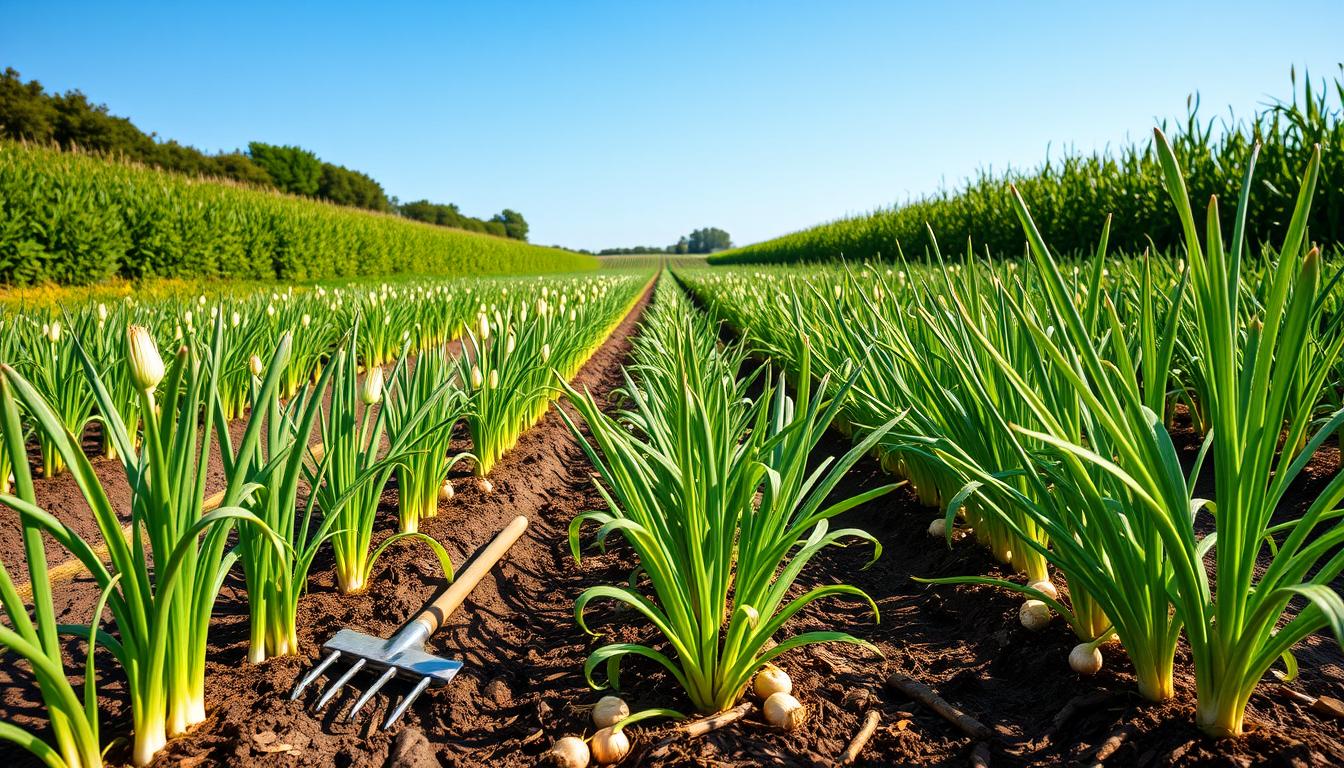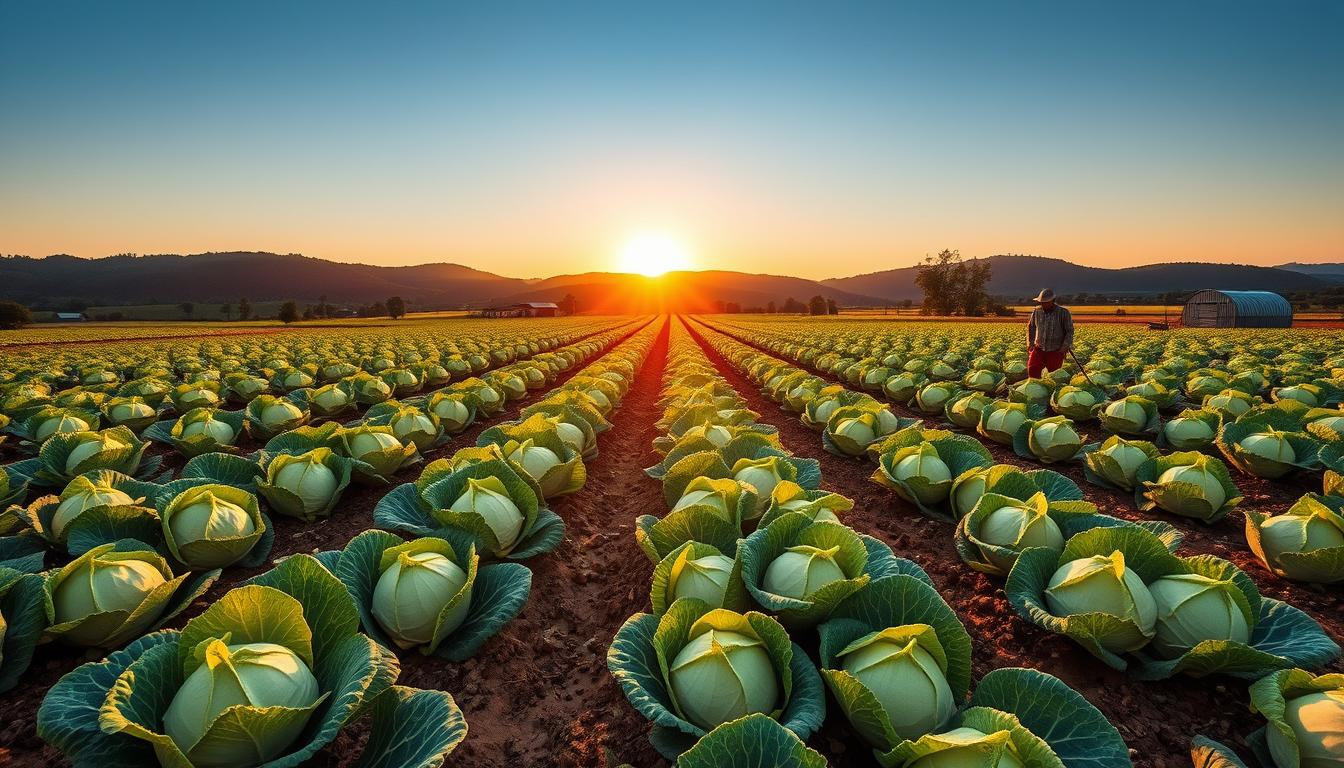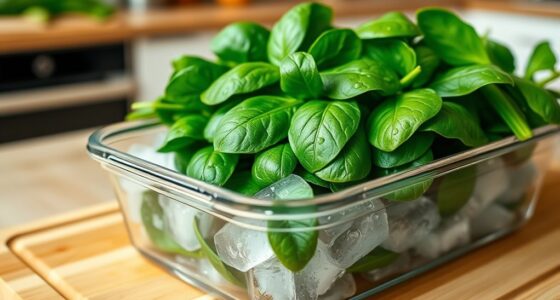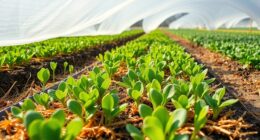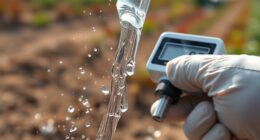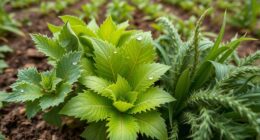Imagine stepping outside into your garden. The sun touches your skin and a soft breeze plays with the leaves. As you move among your plants, seeing vibrant green shoots pop up from the earth is truly satisfying. Each shoot is a sign of your hard work and dedication. Growing onions doesn’t just offer a rewarding harvest. It also connects you more deeply with the earth. Each onion bulb has its own story, a tale of your efforts and patience. In this guide, we’ll share key tips to help you grow healthy onions. You’ll enjoy the process of planting, whether you’re just starting out or have a green thumb.
Key Takeaways
- The best soil pH for onions is between 6.2 and 6.8 for optimal growth.
- Onions need around 20 to 22 inches of water per season to develop large bulbs.
- Regular fungicide applications every 10-14 days can prevent diseases.
- Planting onion sets is a convenient option for faster results.
- Onion plants require sunlight hours based on their specific categorization.
Introduction to Growing Onions
Starting your onion-growing journey is both fun and fulfilling. This introduction to onions covers the key onion growing basics. Every aspiring gardener can follow these. You don’t have to feel overwhelmed by the process. With a bit of effort and the right approach, you’ll enjoy gardening success.
Onions do best when spaced about 6 inches apart, in rows 12 inches apart. This helps them grow strong and healthy. The best soil pH for onions is from 6.0 to 6.8. This ensures they get all the nutrients they need. It’s important to water the plants when the soil’s top inch feels dry. Since onion roots are shallow, they need steady water to grow well.
When you plant onions, put them 1 inch deep in the ground. For those starting with seedlings, pick ones about as thick as a pencil. This helps grow big bulbs. Plant these big seedlings 2 inches apart. This is perfect for delicious spring onions.
After all your hard work, onions are ready to pick when they’re big and the tops yellow and fall over. After picking, cure your onions in a warm, breezy spot for 7 to 10 days. This helps keep them fresh.
By sticking to these tips, your gardening hobby can bring delicious results to your table. The adventure of growing onions leads to great dishes and pride in your gardening skills.
Choosing the Right Location for Your Onion Plants
Starting your onion garden begins with picking the best spot. This choice affects how well and healthy your onions grow. When choosing where to plant onions, think about how much sun they’ll get and how the soil drains.
Importance of Sunlight
Onions need a lot of sunlight to grow right. Look for a spot that gets 6 to 8 hours of direct sun every day. Onions need about 14 hours of light to make healthy bulbs. So, a sunny spot is key for a big harvest.
Soil Drainage Considerations
Healthy onions need soil that drains well. They thrive in soil that lets water flow through without holding too much moisture. Using raised beds, about 4 inches high, helps with soil drainage and air flow. Checking your soil’s drainage before you plant can protect your onions from water issues.
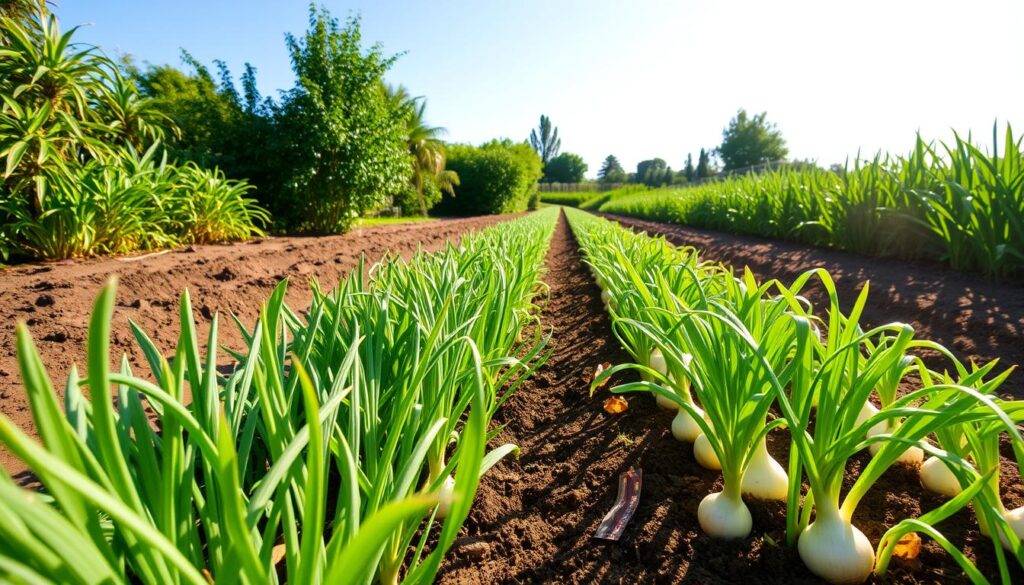
| Aspect | Recommendations |
|---|---|
| Sunlight | 6-8 hours of direct sunlight daily |
| Drainage | Well-drained soil; consider raised beds for better aeration |
| Bulb Formation | Requires 14 or more hours of daylight |
| Watering | Maintain moisture; check soil regularly for saturation |
Choosing the right Onion Location is vital. Make sure it gets enough sunlight and has good drainage. This sets the stage for growing great onions.
Understanding Soil Requirements for Onions
Knowing what onions need from their soil is key to a great harvest. The right soil mix makes a big difference in their growth and quality. It’s very important to check the soil pH and add organic matter to your soil for a great onion garden.
Optimal Soil pH for Onions
Onions do best in soil with a pH from 6.2 to 6.8. This pH range helps them get nutrients well. You can test your soil’s pH with kits from gardening stores or local agricultural services.
If the pH isn’t right, you can fix it. Add ground limestone to increase the pH or peat moss to lower it. Getting the pH right is crucial for the onion soil requirements and their growth.
Improving Soil Quality with Compost
Adding compost to your garden betters soil fertility and structure. The compost benefits include better water retention and air flow, which onions need for healthy bulbs. Mix organic compost into the top few inches of soil. This helps with nutrients and supports good microbes. These improve conditions for your onions.
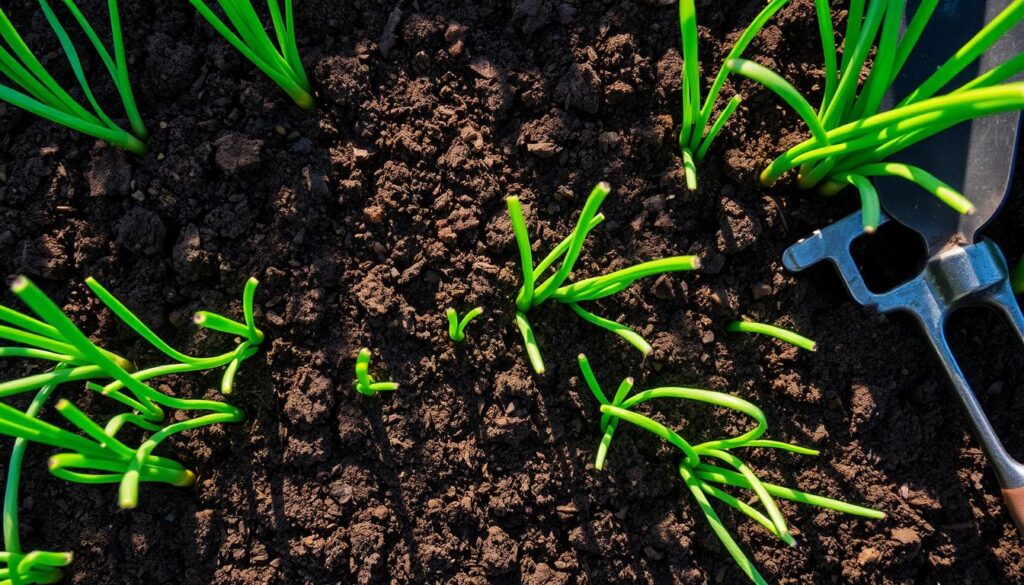
| Soil Type | Characteristics | Suitability for Onions |
|---|---|---|
| Loam | Balanced mixture of sand, silt, and clay | Ideal for growing onions |
| Sandy | Drains quickly but retains moisture poorly | Less suitable without additional moisture management |
| Clay | Retains water but drains poorly | Not recommended; amendments needed for proper drainage |
By knowing and meeting the onion soil requirements, you can create the best growing conditions. Adjusting soil pH and adding compost are key first steps. They ensure strong onion growth and a good harvest.
Best Practices for Onion Planting
Understanding the right timing and techniques is key to successful onion growth. It’s important to consider the climate and different onion varieties. Each type needs specific conditions based on day-length needs. This affects planting time and growth success.
When to Plant Onions
The right time to plant onions is crucial for a good harvest. For most places, this is 4-6 weeks before the last frost. In southern Arizona, plant onion seeds from October to November. Onion plants do best from November to January there. It’s vital to choose the right type of onion based on their light needs.
Planting Techniques and Depth
Focus on the depth and spacing when planting onions. Seeds or seedlings should be about 1 inch deep. For spacing, place them 4 inches apart in rows that are 8 inches apart. Using square foot gardening? 5-9 onions per square foot is ideal. These methods ensure onions have enough space and nutrients. The right spot and soil quality are also crucial.
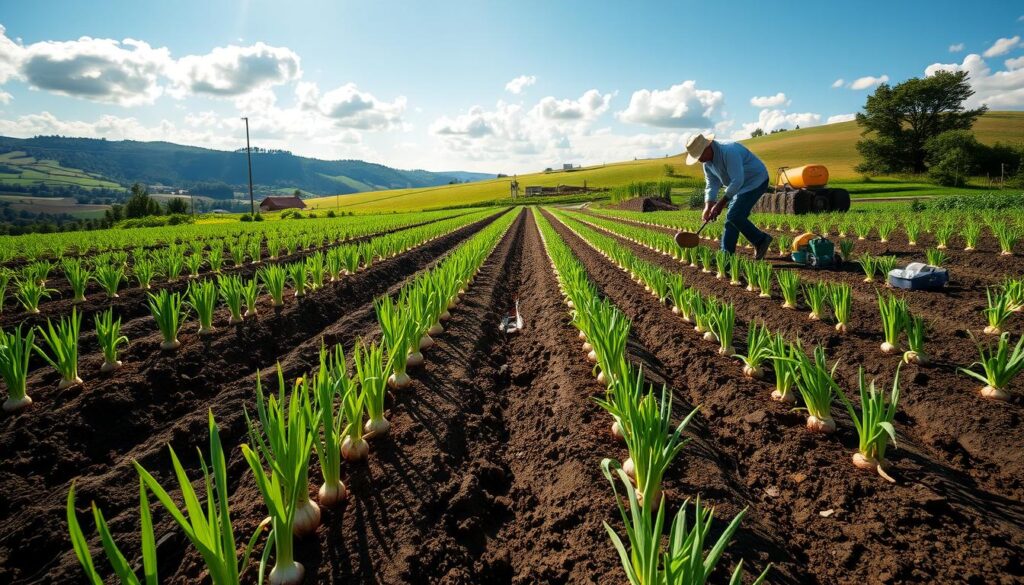
Growing Onion – Farming Tips
Knowing how to space onions and picking the right types can really boost your success in growing onions. By placing them just right in your garden, you get the best growth and easy care.
Spacing and Arrangement
Onions do best with space to grow. You should plant them 6 inches apart with rows 12 inches apart. This setup helps air move around, lowers disease risk, and gives bulbs space to grow.
Choosing the Right Onion Varieties
Not every onion is the same. The Best Onion Varieties depend on where you live and how much sunlight they get. You have short-day, intermediate-day, and long-day onions, each needing different light amounts. Trying out hybrid onions can give you bigger onions than open-pollinated ones. For sweeter onions, try Texas Sweet or Walla Walla in the right climates.
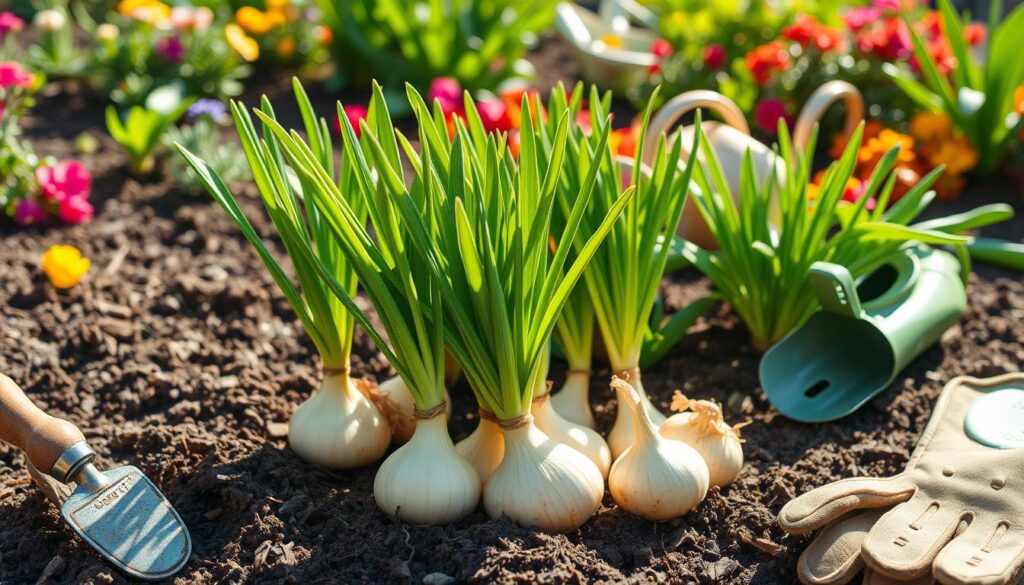
Watering Techniques for Healthy Onion Growth
Knowing how to water onions right is key for their growth. They do well when their water needs are met. To get big, quality bulbs, watch and adjust how you water based on the weather.
Understanding Onion Water Needs
Onions need about 20 to 22 inches of water during their growing phase. It’s important to keep the soil evenly moist. You should aim to water them weekly unless it rains enough. Yet, too much water can harm them. Sandy soil might need more water than loamy soil because it doesn’t hold moisture as well.
Effective Watering Methods
Drip irrigation or soaker hoses are great for watering onions. They help avoid fungal diseases by keeping leaves dry. Pay close attention to watering as harvest nears. Cut back on water when the tops turn yellow and droop to avoid split bulbs.
- Aim for at least 1 inch of water per week for optimal bulb growth.
- Remove weeds promptly to enhance water availability for your onions.
- Utilize ample compost mixed with nitrogen-rich fertilizers to support robust onion growth.
Following these watering strategies will help your onions grow strong. This sets the stage for a great harvest.
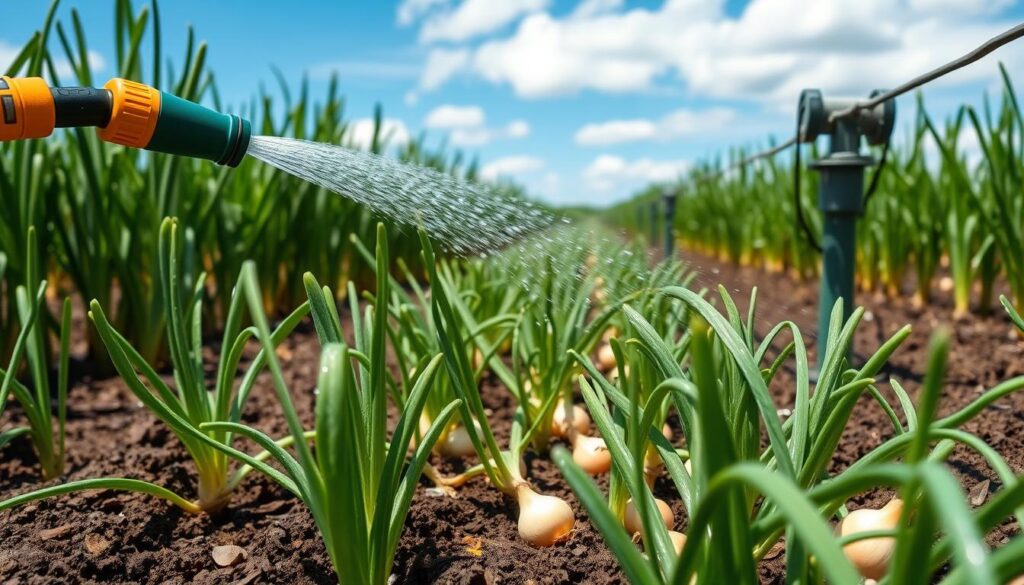
| Soil Type | Weekly Water Requirement | Potential Issues from Overwatering |
|---|---|---|
| Sandy | More than 1 inch | Yellowing leaves |
| Loamy | 1 inch | Healthy growth |
| Clay | Less than 1 inch | Bulb rot |
Fertilization and Nutrient Management
Onions need a lot of food to grow well. Starting with Fertilization Tips for Onions is key for healthy plants. Use a high-phosphorus organic fertilizer when you plant. It gives your onions a great start. Then, add nitrogen-rich fertilizers every 2 to 3 weeks. This will make your crops stronger.
It’s important to keep an eye on soil health for Nutrient Management. Test your soil every year to know its nutrients. Also, do weekly plant tests during the season. If your onions need more phosphorus, go ahead and add some. Your onions will grow better.
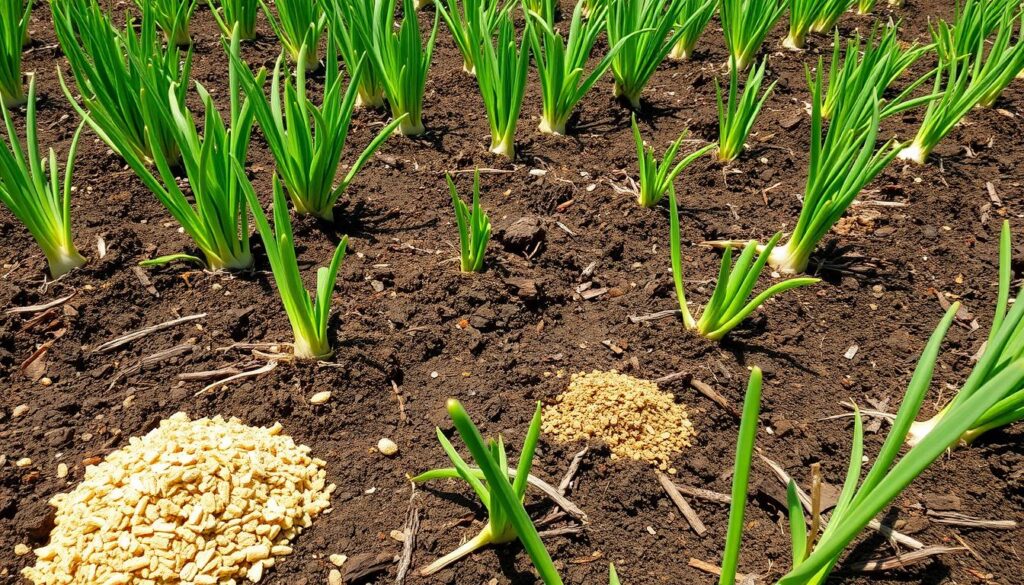
How you put fertilizer on your onions affects their growth. There are four ways: broadcasting, foliar, placement, and fertigation. Fertigation, mixing fertilizer with water, works really well. It saves money, time, and water, and helps control nutrients better.
Using drip irrigation with fertigation is best for onions. It uses water wisely and keeps nitrogen from leaking. These methods help your crops do better with less harm to the environment. Good fertilization means your onion beds will be successful and produce a lot.
Protection Against Pests and Diseases
Keeping onions safe from pests and diseases is key for a good crop. Onion plants face many challenges that can stop their growth and hurt your harvest. By knowing what issues may arise, you can act early to keep your onions healthy.
Common Onion Pests to Watch For
Onions often deal with thrips and root maggots. Thrips make leaves turn gray and weak. Cool, humid weather brings white rot, hurting roots and leaves. If not handled quickly, these problems can linger.
- Onion Thrips: Leaves turn gray and plants become weakened.
- Onion Root Maggots: Lay eggs at the base of plants, causing serious damage.
- White Rot: Affects crops in cool weather; spoiled bulbs can harbor spores for years.
- Purple Blotch and Blight: Fungal diseases that thrive in wet conditions.
Effective Disease Prevention Strategies
To fight Onion Growing Issues, use several strategies. Space your onion sets properly to allow air flow and stop fungus. Check your plants regularly for early signs of pests or disease.
Use both organic and chemical pest control solutions. Products like Ferti-Lome® Broad Spectrum Landscape & Garden Fungicide and Monterey Complete Disease Control help. Also, clear garden debris in fall to avoid pests and diseases next year.
| Pest/Disease | Symptoms | Control Measures |
|---|---|---|
| Onion Thrips | Gray leaves, weak plants | Insect netting, Neem oil |
| White Rot | Rotting roots and bulbs | Crop rotation, proper sanitation |
| Root Maggots | Plant wilting, root damage | Pesticides, insect traps |
| Purple Blotch | Dark lesions on leaves | Fungicides, crop rotation |
| Blight | Yellowing and decay | Clean gardening practices, fungicides |
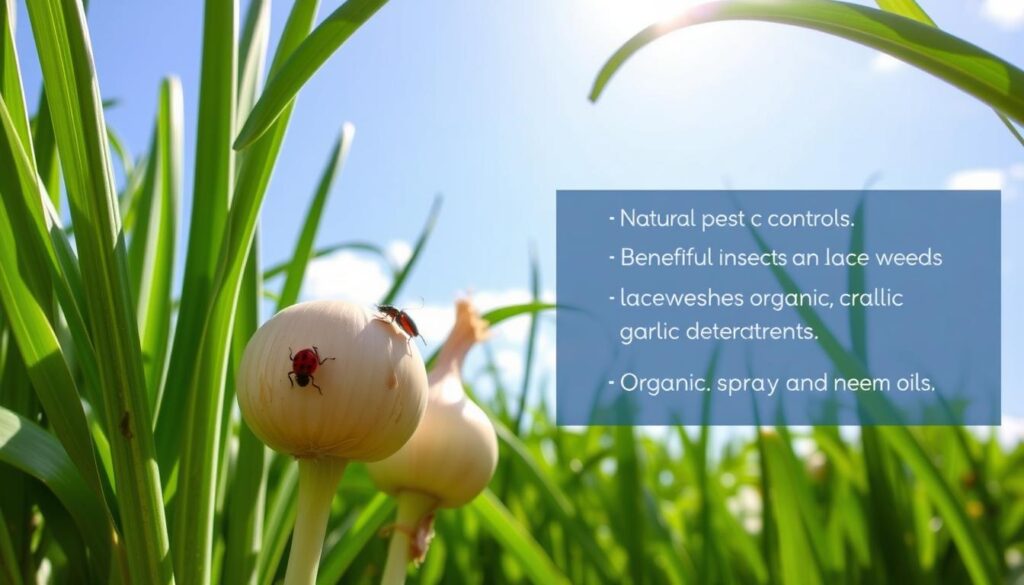
Always maintain and check your plants to avoid pests and diseases. Being prompt and using effective controls can greatly improve your onion crop’s health and yield.
Harvesting Your Onions
It’s vital to harvest onions properly to enhance their taste and extend shelf life. Knowing the right harvesting signs tells you when it’s time to pick them. Onions usually mature 90 to 100 days after planting, though some types may need different conditions.
Signs That Your Onions are Ready to Harvest
Watch your onion plants for signs they’re ready:
- Yellowing tops that begin to droop.
- A noticeable change in the foliage’s color and health.
- When the tops fall over, the bulbs are usually mature.
Picking onions in late summer, when you see these signs, ensures they taste great and last longer.
Proper Harvesting Techniques
Using the right techniques for harvesting is key to keep your onions fresh. Here’s what to do:
- Loosen the soil around them with a spading fork gently.
- Carefully lift the bulbs to avoid any harm.
- Let the onions dry in a place with good airflow for 7 to 10 days.
These steps help get onions ready for storage. Store them in mesh bags or cardboard boxes in a cool, dry spot. Keep them away from apples, which can spoil them.
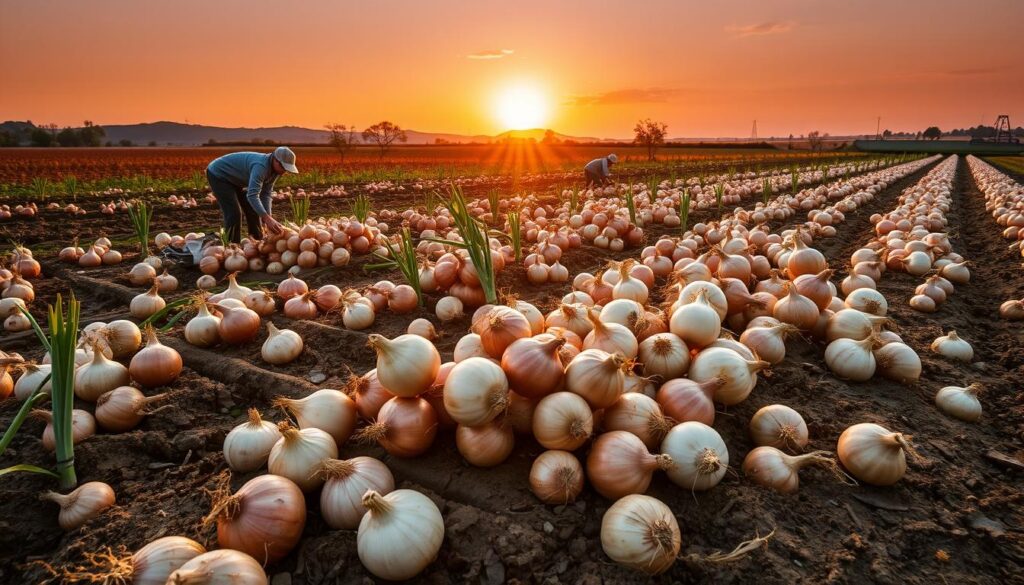
Storing and Curing Onions for Longevity
It’s really important to store onions the right way to keep them fresh longer. Doing the correct steps for curing and storing onions will help them stay fresh for months. Here are some key long-term storage tips to keep your onions in great shape.
Steps for Curing Onions
Curing onions helps them last longer. This process dries the onions out to stop them from rotting. Here’s how to do it:
- Spread your onions out in a warm, shaded place with lots of air moving around.
- Keep the area at 75°F to 80°F during the curing.
- Let the onions cure for 2 to 4 weeks until the tops are dry and the skins are papery.
- Cut off the roots and the tops before you store them.
Proper Storage Conditions
Onions need certain conditions to stay good after curing. Keep these things in mind:
- Keep onions in a cool, dry spot away from light and moisture. The best temperature is between 32°F to 45°F with humidity at 65% to 70%.
- Store them in something that lets air move, like mesh bags, paper bags, or crates.
- Always check your onions for any signs of going bad, like sprouting or rotting.
Using these storage tips, you’ll likely see very little spoilage. These guidelines will help you enjoy your onions for a really long time.
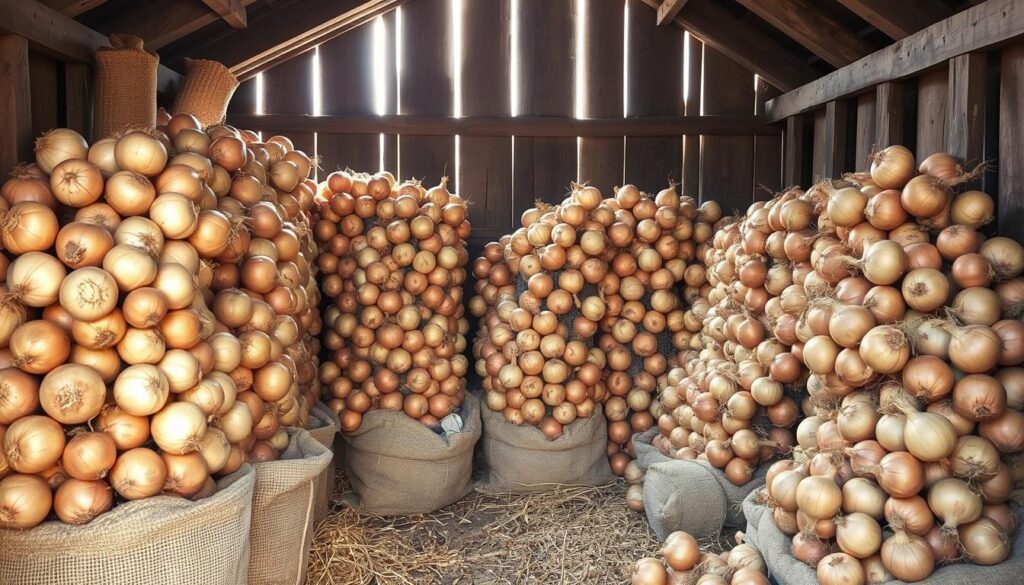
| Onion Variety | Storage Duration |
|---|---|
| Red Wethersfield | 12+ months |
| Copra | 10 to 12 months |
| Stuttgarter | 10 to 12 months |
| Texas Legend (Short Day) | 3 to 4 months |
| Mild Onions | 2 to 3 months |
| Pungent Onions | Up to 6 months to 1 year |
Troubleshooting Common Onion Growing Issues
Onions can face several challenges as they grow. Spotting and tackling these Common Onion Issues early can lead to a fruitful harvest. A major challenge is bolting, where onions flower too soon because of stress such as temperature changes. Here, you’ll discover how to handle Troubleshooting Bolting and keep growth conditions ideal.
Dealing with Bolting Onions
Bolting can spoil your onion harvest, transforming potential big bulbs into unwanted flowers. This problem can stem from uneven watering, planting unsuitable onion varieties, or stress from the environment. Here are effective ways to lessen this issue:
- Pick transplants that are pencil-width for strong growth.
- Avoid sets meant for green onions unless you want those specifically.
- During the bulbing phase, ensure onions get enough nitrogen.
- Water regularly, aiming for 1 inch per square foot each week.
- For bigger bulbs, space onions 6 to 8 inches apart.
- Use mulch to keep moisture and keep weeds at bay.
Spotting any onions bolting calls for immediate use since they won’t store well. By providing the right care and a watchful eye, you can reduce stress on your onions. This helps create the perfect growing conditions for them to thrive.
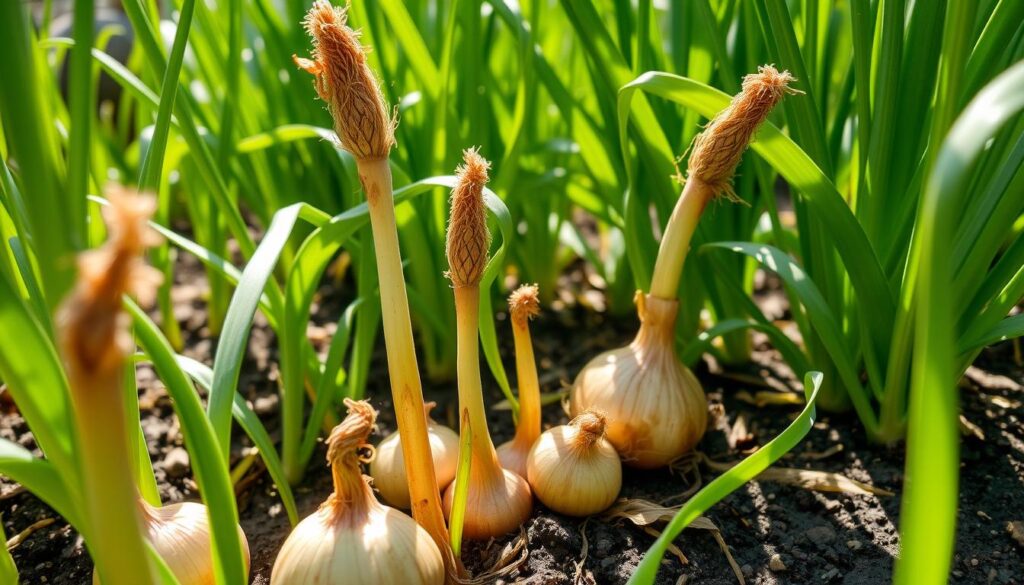
| Problem | Causes | Solutions |
|---|---|---|
| Bolting | Temperature stress, inadequate watering, wrong variety | Choose the right transplant size, ensure steady watering |
| Stunted Growth | Dense planting, poor soil | Space properly, enrich soil with good compost |
| Rot and Disease | Too much water, bad drainage | Improve drainage, water as needed |
Conclusion
Growing onions successfully is all about mixing knowledge with hard work. Follow the tips in this article to boost onion growth and get more from your harvest. Choose the right onion type for your area. This could be short-day, intermediate-day, or long-day onions.
Soil is key, so check its pH and organic matter. These affect your onions’ health and yield. Water regularly, fertilize wisely, and keep pests away. These steps will improve your chances of a big harvest. Try different methods and harvesting times to see what’s best for you.
With the right plan and dedication, growing onions can be easy. Embrace the process, make smart choices, and enjoy watching your onions grow. They’ll make your meals even better all year round.

